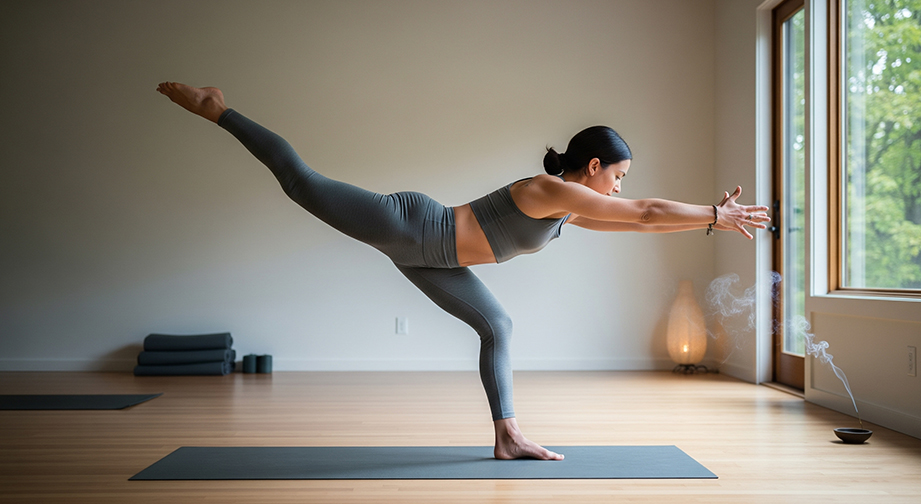Virabhadrasana III (Warrior III Pose) – A Beginner-Friendly Guide
Introduction
Virabhadrasana III, also known as Warrior III Pose, is a dynamic standing yoga asana that challenges your balance, tones your muscles, and sharpens your focus. The Sanskrit name "Virabhadrasana" honors the fierce warrior Virabhadra from yoga mythology, while "III" signals the third and most balancing variation of the Warrior series.
Essence: Balancing. Energizing. Empowering.
If you’ve ever felt wobbly standing on one leg or stiff after long hours at your desk, this pose is your new best friend. Warrior III teaches you to find strength, poise, and composure—even when you’re off-balance.
Step-by-Step Guide to Virabhadrasana III

- Start in Mountain Pose (Tadasana):
Stand tall, feet together, grounding down through your feet. Shoulders relaxed.
- Move into Warrior I:
Step your right foot back about 3 feet, bend your left knee (front knee), and lift your arms overhead.
- Transition Forward:
Shift your weight onto your left leg. On an inhale, reach your arms forward, lengthen your spine, and prepare to lift off.
- Lift the Back Leg:
On an exhale, slowly lift your right (back) leg up behind you, straightening it and keeping your hips level.
- Balance:
Your chest, arms, and back leg should form a single straight line, parallel to the floor.
Gaze slightly forward or down. Keep your standing leg strong, core engaged.
- Hold:
Breathe naturally, smooth and steady. Hold for 15–30 seconds (3–5 breaths) per side. Repeat 2–3 rounds.
- Release:
On an exhale, gently lower your back leg and stand tall. Switch sides.
Beginner-Friendly Modifications:
- Place your hands on your hips or out to the sides for added balance.
- Rest your lifted foot on a wall behind you or use a chair under your hands for support.
To Intensify:
- Bring palms together in front of your chest or extend your arms overhead (biceps by ears).
- Try closing your eyes for an extra balance challenge.
Alignment & Safety Tips
- Keep hips level—imagine both hip bones shining down evenly toward the floor.
- Keep a micro-bend in your standing knee to avoid locking the joint.
- Engage your core for balance and back protection.
- Energy Out: Reach hands forward and back heel behind you—lengthen from fingertips to heel.
Common Mistakes:
- Letting the raised hip lift too high (tip: square hips to the ground).
- Collapsing the chest (tip: broaden collarbones, keep spine long).
- Hyperextending or locking the standing knee.
Safety Precautions:
- If you have balance issues, use a wall or sturdy chair.
- Avoid if pregnant or with recent hip, knee, or ankle injury.
- Listen to your body; never force the pose.
Benefits of Warrior III Pose
Physical Benefits
- Strengthens legs, ankles, and core muscles
- Tones glutes and shoulders
- Improves balance and body coordination
- Supports healthy alignment and posture
Mental Benefits
- Promotes focus and concentration
- Builds mental stamina and resilience
- Calms the mind and reduces stress
Energetic / Chakra Connection
- Stimulates the Manipura Chakra (solar plexus)—associated with self-confidence and personal power
- Invokes feelings of steadiness and determination
Contraindications
- Avoid if you have uncontrolled high blood pressure, recent hip/knee/ankle injuries, or are recovering from surgery.
- Pregnant practitioners or those with severe balance issues should choose safe alternatives.
- Alternative: Try supported Warrior III with your hands on a wall or chair!
Beginner's Tips & Variations
- Use Props: Place your hands on yoga blocks or a chair for stability.
- Practice next to a wall—gently press the lifted foot against it for support.
- Gentle Variation: Keep your raised leg slightly lower or arms by your sides for more ease.
- Advanced Variation: Try a "Warrior III crunch": draw your knee to your chest and then extend it back out, keeping balance.
How to Include Warrior III in a Yoga Flow
- Works well as a main practice pose or in a standing sequence.
- Pairs well with: Warrior I (Virabhadrasana I), High Lunge (Alanasana), and Half Moon Pose (Ardha Chandrasana).
- Follow up with a gentle forward fold or Downward Dog to release the back and legs.
Mind–Body Connection
Practicing Virabhadrasana III is an opportunity to cultivate mindful awareness and presence. Notice the small shifts in your body, your breath, and your mental state. As you balance physically, you'll likely find moments of stillness and clarity—reflecting the pose’s connection to inner strength and determination.
Chakra: This pose deeply activates the solar plexus chakra, inviting you to step into your personal power with confidence.
Summary Box
- Asana Name: Warrior III Pose (Virabhadrasana III)
- Level: Beginner–Intermediate
- Focus Areas: Core, legs, back, shoulders, glutes
- Duration: 15–30 seconds per side (2–3 rounds)
- Best Time to Practice: Morning or evening, when energy and focus are available
FAQs about Virabhadrasana III
Q1: Is Warrior III suitable for beginners?
A: Yes! Use props or a wall for balance, and work up gradually.
Q2: Can Warrior III help with posture?
A: Absolutely. It strengthens the back and core, supporting excellent posture.
Q3: How can I stop wobbling in this pose?
A: Focus on steady breath, gaze (drishti), and use a wall or chair for support while you build balance.
Remember, every master was once a beginner. Stay curious, practice regularly, and enjoy your journey with Virabhadrasana III!